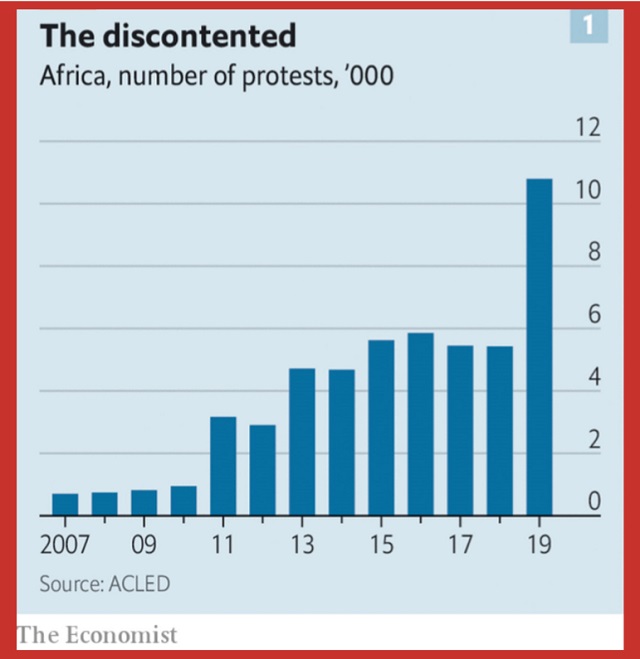
The winners will vary, depending on the balance of forces in each country. On one side are the electoral authoritarians, operating in a conducive international environment. On the other are trends that will make their reigns more difficult.
One is demography. Africans are young. Most were born in the 21st century (most people in the EU were born before 1978). They are also rapidly urbanising: 21 of the world’s 30 fastest-growing cities are in Africa. Both trends are disruptive for old parties run by old men that depend on old rural voters. Young Africans, like young people almost everywhere, have weaker ties to traditional parties. African city-dwellers are more likely to oppose incumbents than their rural peers, who are less well educated, have fewer sources of information and are more easily intimidated.
Africa’s young populations have inspired breathless talk of a “demographic dividend”. But because birth-rates remain high, the share of working-age people in African countries remains generally lower than in Asian countries in the 20th century. African economies are also not producing enough opportunities for young people—another destabilising force. Economic growth for sub-Saharan Africa will be about 3.4% per year over the next five years, predicts Capital Economics, a consultancy in London. That is not much faster than population growth.
And it is bad news for the 1m or so Africans who enter the labour market every month. Fewer than one in four will get a formal job, reckons the Africa Growth Initiative based at the Brookings Institution, another Washington think-tank. The rest face a more precarious future in the informal sector—precisely the type of jobs done by those who swell political protests. Data from the World Bank suggest that social mobility is lower in Africa than in almost any other part of the world.
It is no coincidence that the wellsprings of protests are slums. Some politicians are already tapping discontented young voters. Bobi Wine, the self-styled “ghetto president” running against Yoweri Museveni in next year’s presidential election in Uganda, is only the most eye-catching.
Lisa Mueller, a political scientist, argues that demonstrations are inspired by a mix of middle-class (usually older) people’s demands for political freedoms and poorer (usually younger) people’s economic grievances. The mix was apparent in Sudan, as protests sparked by rising bread prices combined with opposition to dictatorship.
There was a similar breadth to protests in Malawi against the dubious re-election of Peter Mutharika, the 79-year-old president, in May 2019. (Dollops of Tipp-Ex were used to alter tally sheets.) The demonstrations led to the Constitutional Court in February ordering a rerun, only the second time judges have done so in African history, following Kenya’s example in 2017.
A great day for freedom
For some it was mainly a victory for freedom. “We can perhaps say that our democracy has begun, 26 years after [the end of Banda’s dictatorship],” reflected Danwood Chirwa, a Malawian lawyer. Younger protesters, however, had more material things on their minds. “I hope for change of government and with that change I will start a small business because the opportunities under the current government are very limited,” said Pikilana Maliza, an unemployed 23-year-old from a township in the capital, Lilongwe.
Malawi’s doughty judges show the importance of institutions. Strong judiciaries, parliaments and the like are checks on arbitrary power. And while many are under political influence, some are willing to act as vehicles for those campaigning for greater democracy.
Take African legislatures. They are often dismissed as rubber-stamp institutions. But they have helped ensure that, since 1990, all but seven of the 47 countries in sub-Saharan Africa that have non-ceremonial heads of state have term limits. These limits are more than twice as likely to be kept as broken.
Institutions cannot always restrain a determined autocrat, but they can raise the costs of him repressing his people and clinging to power. This is one reason why there has been a rise in the number of peaceful, if not always democratic, changes of government (see chart 2). There have been 29 non-violent transfers of power since 2015, compared with just nine in the first half of the decade. Of the 49 sub-Saharan leaders in charge at the start of 2015, just 22 are in place today. Many of these changes reflect deals among elites, such as the one that brought Abiy to power in Ethiopia. But they show that political systems do respond to pressure.
The forces for and against democracy will shape African countries in different ways. Nic Cheeseman of the University of Birmingham expects there to be a “growing democratic divide” on the continent, as politics in countries such as Botswana, Ghana, Namibia and South Africa become more competitive, while authoritarian states become more repressive.
The future of more fragile democracies, like Benin, is less certain. But Mr Sossoukpe is determined to ensure that the repression unleashed by Mr Talon is temporary. Citing the role of his father who helped topple Kérékou, the dictator, he adds: “I see it as a duty to my children to keep fighting.”
****
The Economist
 The Independent Uganda: You get the Truth we Pay the Price
The Independent Uganda: You get the Truth we Pay the Price


